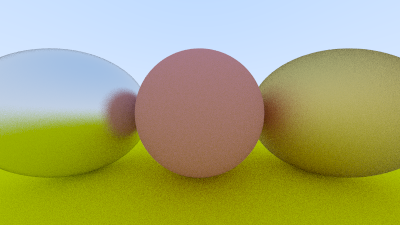
이 글은 Peter Shirley의 Ray Tracing in One Weekend를 번역한 것입니다.
Ray Tracing in One Weekend를 공부하면서 다시 한번 복습하는 느낌으로 번역을 해보려고 합니다. 영어가 서툴러 번역이 잘못되었을 수도 있으므로 잘못된 부분을 발견하신다면 지적해 주시면 감사하겠습니다.
9.1 An Abstract Class for Materials
만약 다른 메테리얼을 가진 또다른 오브젝트를 원한다면, 설계 결정사항을 가지고 있습니다. 많은 매개 변수와 다른 메테리얼 타입을 가진 범용적인 메테리얼을 만들 수 있습니다. 이건 나쁜 접근 방식이 아닙니다. 또는 동작을 캡슐화하는 추상 메테리얼 클래스를 만들 수 있습니다. 저는 후자의 접근 방식을 좋아합니다. 우리의 프로그램의 경우 메테리얼은 두 가지 작업을 필요로 합니다:
- 산란 광선을 생성한다(또는 입사 광선을 흡수한다).
- 산란된 경우, 광선이 얼마나 감쇠되어야 하는지 설정한다.
다음이 추상 클래스입니다:
#ifndef MATERIAL_H
#define MATERIAL_H
#include "rtweekend.h"
struct hit_record;
class material {
public:
virtual bool scatter(
const ray& r_in, const hit_record& rec, color& attenuation, ray& scattered
) const = 0;
};
#endifListing 41: [material.h] The material class
9.2 A Data Structure to Describe Ray-Object Intersections
hit_record로 인수를 많이 사용하는 것을 피할 수 있습니다. 원하는 정보를 무엇이든지 거기에 넣을 수 있습니다. 인수를 사용할 수도 있습니다; 취항의 문제입니다. Hittables와 materials는 서로를 알아야 합니다. 그러므로 순환 참조 상태를 가지고 있습니다. C++에서는 포인터가 클래스를 가리킨다고 컴파일러에게 알려주기만 하면 됩니다. hittable 클래스 안의 "class material"는 다음과 같습니다:
/* ************* 추가 ************ */
#include "rtweekend.h"
class material;
/* ******************************* */
struct hit_record {
point3 p;
vec3 normal;
/* ************* 추가 ************ */
shared_ptr<material> mat_ptr;
/* ******************************* */
double t;
bool front_face;
inline void set_face_normal(const ray& r, const vec3& outward_normal) {
front_face = dot(r.direction(), outward_normal) < 0;
normal = front_face ? outward_normal : -outward_normal;
}
};Listing 42: [hittable.h] Hit record with added material pointer
여기서 메테리얼을 설정한 것은 광선이 표면과 어떻게 상호작용하는지를 알려줍니다. hit_record는 여러 인수를 단지 구조체에 넣은 방식입니다. 그러므로 그룹의 형태로 인수들을 보낼 수 있습니다. 광선이 표면을 교차할 경우(예를 들어, 특정 구), hit_record의 메테리얼 포인터는 main()를 실행했을 때 설정된 구의 메테리얼 포인터를 가리키도록 설정됩니다. ray_color()이 hit_record를 가져오면 메테리얼 포인터의 멤버 함수를 호출하여 어떤 광선이 산란되었는지 알 수 있습니다.
이것을 구현하기 위해, sphere 클래스에는 hit_record로 리턴될 메테리얼의 참조를 반드시 가지고 있어야 합니다. 아래의 하이라이트 된 줄을 보십시오:
class sphere : public hittable {
public:
sphere() {}
/* ************* 수정 ************ */
sphere(point3 cen, double r, shared_ptr<material> m)
: center(cen), radius(r), mat_ptr(m) {};
/* ******************************* */
virtual bool hit(
const ray& r, double tmin, double tmax, hit_record& rec) const override;
public:
point3 center;
double radius;
/* ************* 추가 ************ */
shared_ptr<material> mat_ptr;
/* ******************************* */
};
bool sphere::hit(const ray& r, double t_min, double t_max, hit_record& rec) const {
...
rec.t = root;
rec.p = r.at(rec.t);
vec3 outward_normal = (rec.p - center) / radius;
rec.set_face_normal(r, outward_normal);
/* ************* 추가 ************ */
rec.mat_ptr = mat_ptr;
/* ******************************* */
return true;
}Listing 43: [sphere.h] Ray-sphere intersection with added material information
9.3 Modeling Light Scatter and Reflectance
9.4 Mirrored Light Reflection
9.5 A Scene with Metal Spheres
9.6 Fuzzy Reflection
출처
Ray Tracing in One Weekend - Peter Shirley
https://raytracing.github.io/books/RayTracingInOneWeekend.html#metal